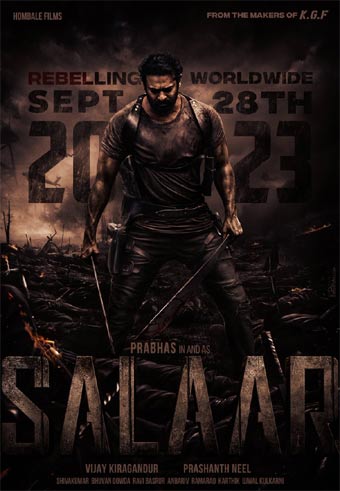Among this past year’s unexpected synchronicities, there’s now a shared space in the Venn Diagram that compares the American singer/songwriter Taylor Swift with the Indian writer/director Prashanth Neel. In 2023, both artists re-released their own re-recorded work, though Neel seems reluctant to describe his latest movie as a remake. Still, the pumped-up action fantasy “Salaar: Part 1—Ceasefire” shares a fair amount of its plot with “Ugramm,” Neel’s 2014 directorial debut. Both movies ultimately concern a civil war within an isolated fictional kingdom ruled by testosterone-fueled muscle guys and their female relatives. And now with “Salaar,” Neel’s fans will join Swifities in getting exactly what they want, a triumphal summary of their favorite artist’s style to date.

Neel has recently admitted that, with “Salaar,” he recast the manga-serial-dense story of “Ugramm” so that it more closely resembles his two-part action epic “KGF,” whose second half was the most expensive Kannada-language movie production to date. (now only tied for second place) Which is to say that “Salaar” also looks brownish-gold and seems to have been filmed on a studio set designed to look like a “Mad Max: Fury Road”-themed desert music festival.
It’s unusual, but not surprising to see Neel’s influence predominate in “Salaar.” The Pan-Indian blockbuster success of “KGF” was big enough to confirm a recent trend: popular directors are now being sold to their mass audience public as visionary auteurs, thanks in no small part to the strong appeal of “RRR” director S.S. Rajamouli’s brand of maximalist counter-mythmaking.
Before Rajamouli, Indian directors were rarely presented as being more important to a movie’s success than their marquee-topping actors. “Salaar” also stars Prabhas, who played Baahubali, the brawny warrior king, in “Baahubali,” Rajamouli’s trend-setting two-part historic romance. In interviews, Neel has said that some of the biggest differences between the stories of “Ugramm” and “Salaar” were inspired by Prabhas and his co-star Prithviraj Sukumaran. There’s still no way to look at “Salaar” without seeing this as Neel’s show, featuring some notable collaborators.
Even “Salaar”’s elaborate plot already feels like a Neel specialty, particularly its labyrinthine structure and heavy emphasis on flashbacks and tangential sub-plots. The first part of “Salaar” introduces viewers to Deva (Prabhas), a dreamboat with a past and a controlling mother (Easwari Rao). Deva loves children and also bonds with Aadhya (Shruti Haasan), an adult woman who also loves her mother (now dead) and is also hiding from a mysterious criminal organization. Aadhya and her pursuers lead Deva back to the powerful, hyper-industrialized Khansaar, an independent nation that looks like a steam-punkified coal mine and industrial slum straight out of “Sonic the Hedgehog 2.” Deva’s return to Khansaar also reunites him with Vardha (Sukumaran), prince of Khansaar.
)
Deva and Vardha’s friendship threads the needle for Neel’s crazy quilt story, uniting flashbacks to climactic boyhood traumas—they were so close and only ten years old, it was 1985!—with perpetually escalating “Game of Thrones”-type feuds between warring Khansaarian leaders. Will Deva bring peace to Khansaar and re-unite with Vardha? No, of course not. This is a story about how two childhood besties grew up to be the kind of rivals whose hatred is so intense that it makes their story too “frightening to think about,” according to some appropriately over-ripe voiceover narration. That line’s especially funny given that it’s delivered right before the surtitle card (“PART 1: CEASEFIRE”) announces an intermission break.
“Would you like to know his story?” the narrator says about half-way through the movie. “His” obviously means Deva, but it could it just as easily mean Neel, who plays up every on-screen movement as if it were a major dramatic event. Neel tends to over-score action with slow-motion a reverb-heavy score and matching sound effects. He also favors Zack Snyder-y speed-ramping in his fight scenes, which alternately winds up and slows down set pieces so that they’re more about poses than choreography.

There’s no question that Neel’s the key to “Salaar”’s success, so it’s hard to get too upset for his reminding us with every italicized, bolded, and underlined flourish. This movie, like his last two movies, feels like a calculated attempt at synthesizing a few different trends into the next mega-trend, including the Pan-Indian appeal of co-stars Prabhas (Telugu language) and Sukumaran (Malayalam). Neel retraces his steps with bolder, harder stresses, like when a group of women chant and shake their ankle bracelets in unison to thank Deva for delivering them from a tyrannical Lord and his rapist son.
Neel’s become a more polished filmmaker since “Ugramm,” and has used what he’s learned to dig his heels deeper into a style that he’s clearly been thinking about for a while now. It shows, even if “Salaar” is just another adolescent fantasy about a righteous savior and a world-ending civil war, coming soon enough in “Salaar: Part 2.”
In theaters now.





